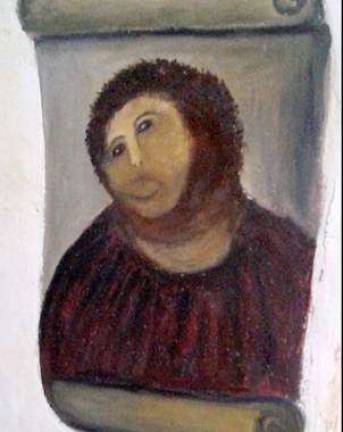The Botched Spanish Fresco Restoration: Ageism in the Art World?

"Despite Good Intentions," states the headline of a New York Times piece about the elderly woman in Spain who performed an amateur "restoration" of a century-old church fresco, "a Fresco in Spain Is Ruined." Good intentions or not, the woman destroyed a priceless, irreplaceable work of art. 80-year-old Cecilia Gimenez took to the more than 100-year-old representation of Jesus in a church in the town of Borja to "repair" the image, which had partially succumbed to moisture on the church walls, reports the Times. Would the subject of her intentions be so thoroughly broached if she were, say, a middle-aged amateur painter who brazenly took to the fresco, armed only with paints and her own ego? Would we be discussing her "Surprisingly Avant-Garde Results," as Art Info describes, for which she is all but entirely unapologetic? To suggest Gimenez's actions are whimsically ignorant is to infantilize someone who knew full well what she was doing, what the piece represented and her own abilities (or lack thereof). She was not a child who unknowingly went at the piece with crayons, though that's what the final product suggested. Art Info details the result: "The direction of his eyes has shifted to a preposterous angle, down and to the left towards the beholder, rather than looking to the upper right. The nose is flattened like that of an African mask. Next to the chimp-like headgear, the new painting's mouth is potentially the strangest alteration: The jaw appears slack with Jesus's tongue seemingly sticking out in either lifelessness or mockery. All in all, what was a minor work of traditional iconography has become a masterpiece of contemporary surrealism." A masterpiece? Contemporary surrealism? She did not merely touch the painting up, she completely altered its appearance. While there is undeniably humor to the situation, to paint Gimenez's act as excusable or sweetly naive because of her age is to engage in ageism, and ageism is damaging to society. She had the presence of mind to pre-meditate and carry out the act, and we must not react as though she were an infant. Instances of art vandalism are harshly punished, whatever the person's intentions. Earlier this year, a man walked up to a 1929 Picasso in Houston, and flagrantly spray-painted it. He was an artist, making an artistic statement, reports the art blog Hyperallergic.com. The man then released a manifesto, detailing the purpose behind his actions: "I dedicate this to all the people out there who have suffered for any injustice of every kind. To those abused by their loved ones. For those abused by their government. For those who were abused by organized religion. And to Picasso from artist to artist. The beast is meant to be conquered. Picasso loved bullfighting because he knew at the end of the dance, someone had to die and on the day it was his turn." The 22-year-old was later charged with criminal mischief and felony graffiti, reported the Houston Press.